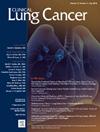与微卫星不稳定性和高肿瘤突变负担相关的极点突变赋予非小细胞肺癌免疫检查点抑制剂治疗的敏感性:一个病例报告和基因组数据库分析。
IF 3.3
3区 医学
Q2 ONCOLOGY
引用次数: 0
摘要
•DNA聚合酶epsilon (POLE)突变已成为晚期实体瘤免疫治疗应答的潜在预测性生物标志物,但在非小细胞肺癌(NSCLC)中并不常见。在这里,我们报告了一位具有高肿瘤突变负担(TMB)和微卫星不稳定性(MSI)的pole突变的非小细胞肺癌患者,他对包括免疫检查点抑制剂的化学免疫治疗方案有完全的反应。我们还查询了公开可用的基因组测序数据库,以了解非小细胞肺癌中POLE突变的患病率。•我们描述了一个68岁的从不吸烟的男性病例,他被诊断为cT3 N0 M0肺腺癌,具有高突变表型,其特征是致病性极点突变、msi高和非常高的TMB(572个突变/百万碱基),由下一代测序确定。完成新辅助纳沃单抗联合卡铂和培美曲塞4个周期后,患者行左上肺叶切除术和纵隔淋巴结清扫,病理反应完全。•DNA测序数据库分析证实,致病性极点突变虽然在非小细胞肺癌中非常罕见,但似乎与导致高TMB的高突变表型相关。这个临床小片段说明了免疫治疗对具有这种表型的非小细胞肺癌的潜在深刻反应。需要进一步的工作来表征POLE突变状态作为潜在有益的预测性生物标志物。本文章由计算机程序翻译,如有差异,请以英文原文为准。
POLE Mutation Associated With Microsatellite Instability and High Tumor Mutational Burden Confers Exquisite Sensitivity to Immune Checkpoint Inhibitor Therapy in Non–Small Cell Lung Cancer: A Case Report and Genomic Database Analysis
- •DNA polymerase epsilon (POLE) mutations have emerged as a potential predictive biomarker for response to immunotherapy in advanced solid tumors, but are uncommon in non–small cell lung cancer (NSCLC). Here we present a patient with POLE-mutated NSCLC with high tumor mutational burden (TMB) and microsatellite instability (MSI), who experienced a complete response to a chemoimmunotherapy regimen that included an immune checkpoint inhibitor. Publicly available genomic sequencing databases were also queried for the prevalence of POLE mutations in NSCLC.
- •We describe the case of a 68-year-old male never smoker who was diagnosed with cT3 N0 M0 adenocarcinoma of the lung with a hypermutated phenotype characterized by a pathogenic POLE mutation, MSI-high, and very high TMB (572 mutations/megabase) as determined by next generation sequencing. Following completion of 4 cycles of neoadjuvant nivolumab with carboplatin and pemetrexed, the patient underwent left upper lobectomy and mediastinal lymph node dissection, and was found to have had a complete pathologic response.
- •Analysis of DNA sequencing databases confirmed that pathogenic POLE mutations, while very uncommon in NSCLC, appear to be associated with a hypermutated phenotype resulting in high TMB. This clinical vignette illustrates the potential for profound response to immunotherapy in NSCLCs harboring this phenotype. Further work is necessary to characterize POLE mutational status as a potential beneficial predictive biomarker.
求助全文
通过发布文献求助,成功后即可免费获取论文全文。
去求助
来源期刊

Clinical lung cancer
医学-肿瘤学
CiteScore
7.00
自引率
2.80%
发文量
159
审稿时长
24 days
期刊介绍:
Clinical Lung Cancer is a peer-reviewed bimonthly journal that publishes original articles describing various aspects of clinical and translational research of lung cancer. Clinical Lung Cancer is devoted to articles on detection, diagnosis, prevention, and treatment of lung cancer. The main emphasis is on recent scientific developments in all areas related to lung cancer. Specific areas of interest include clinical research and mechanistic approaches; drug sensitivity and resistance; gene and antisense therapy; pathology, markers, and prognostic indicators; chemoprevention strategies; multimodality therapy; and integration of various approaches.
 求助内容:
求助内容: 应助结果提醒方式:
应助结果提醒方式:


